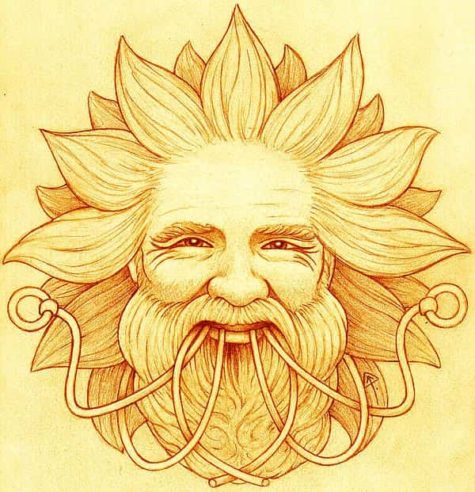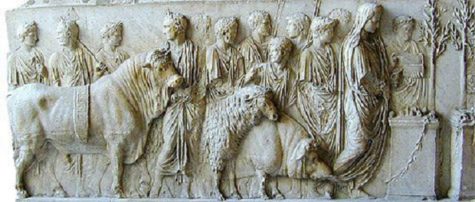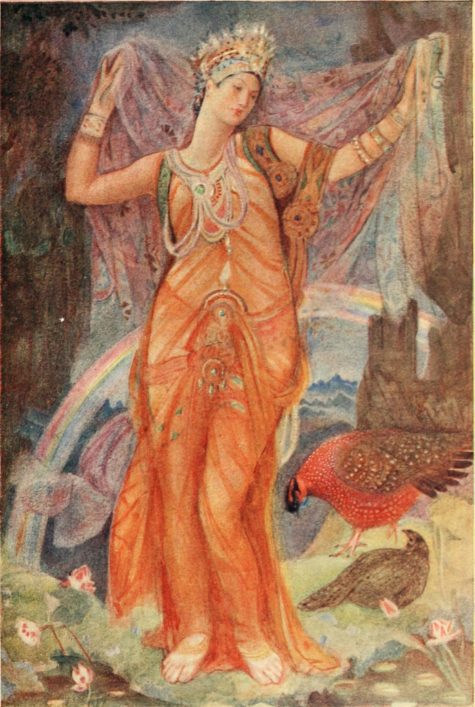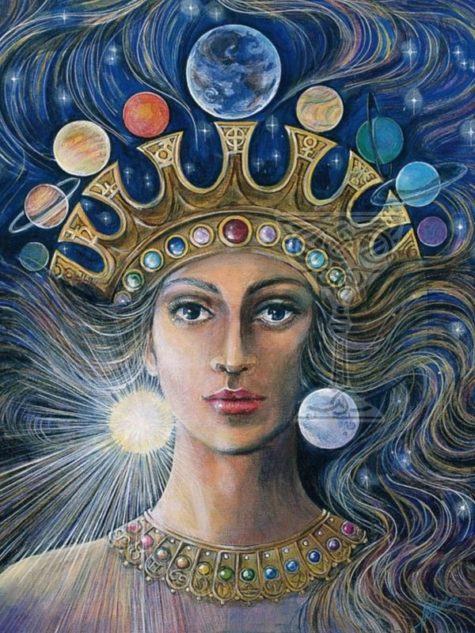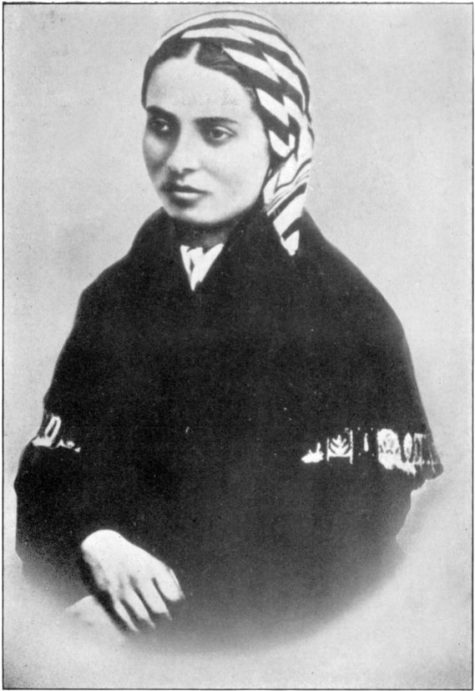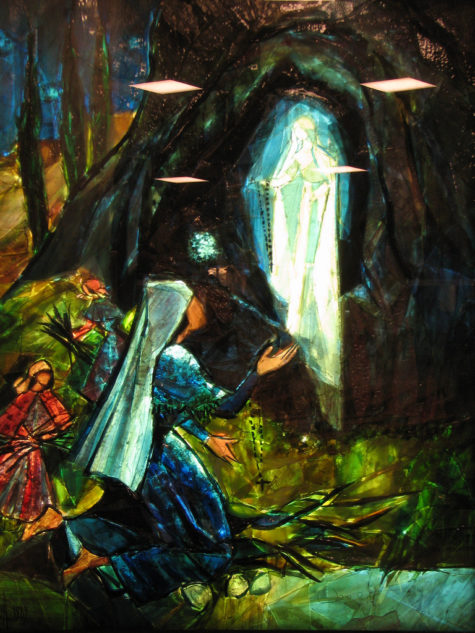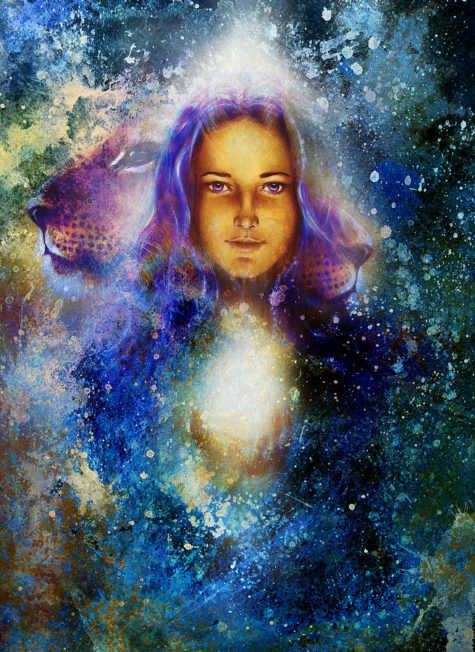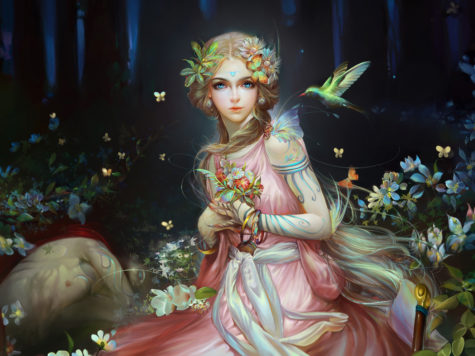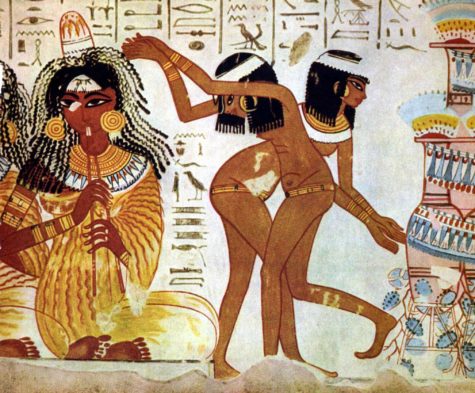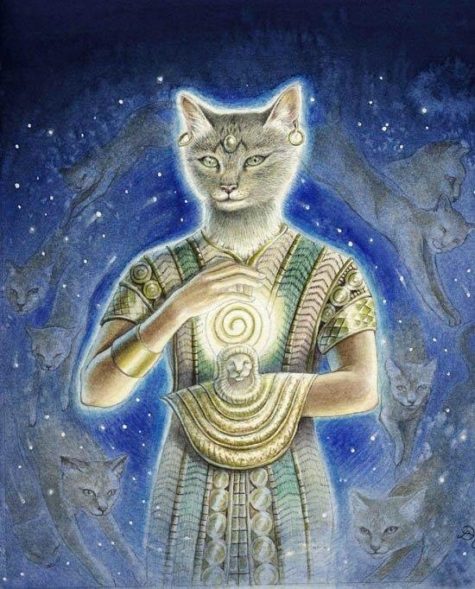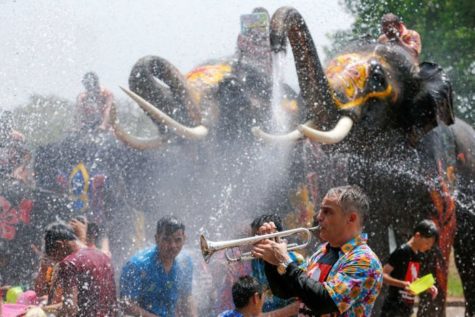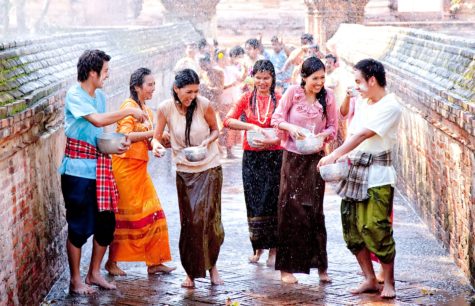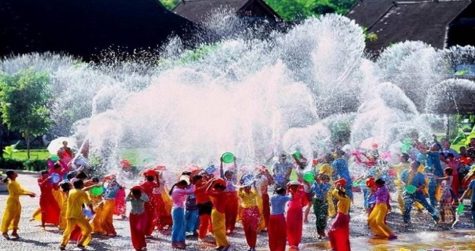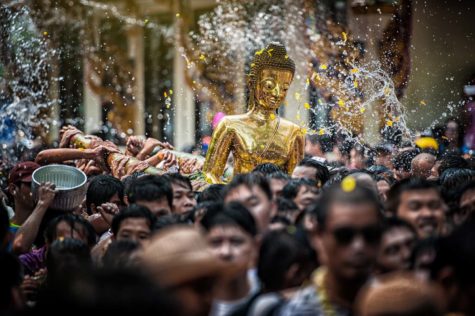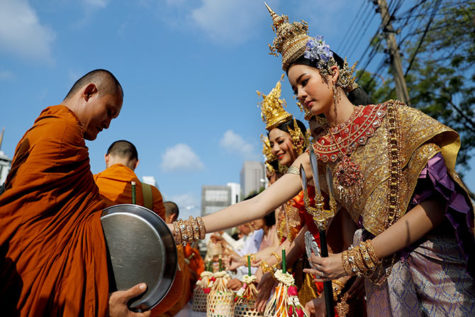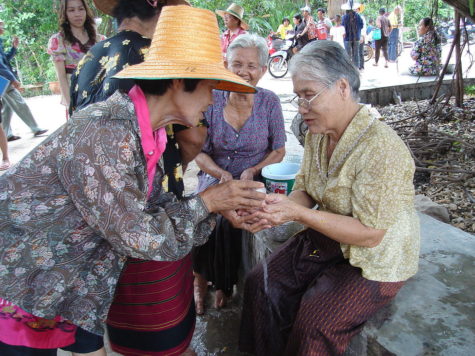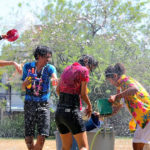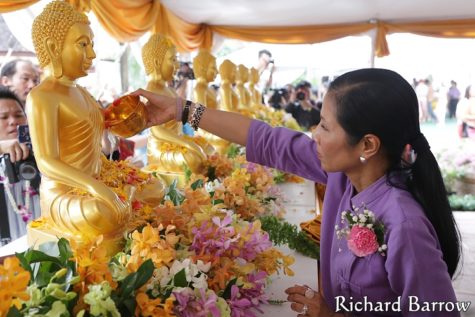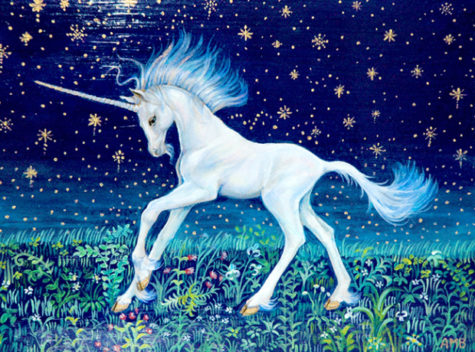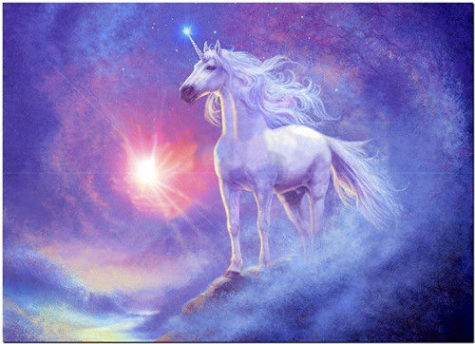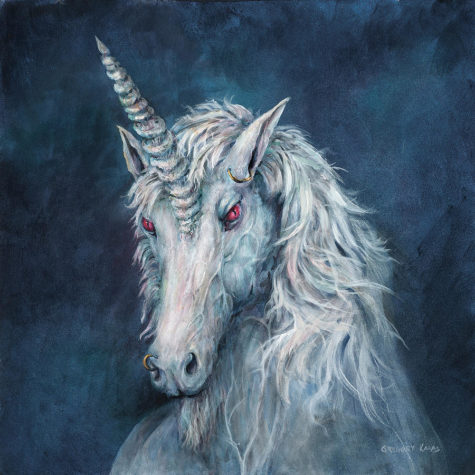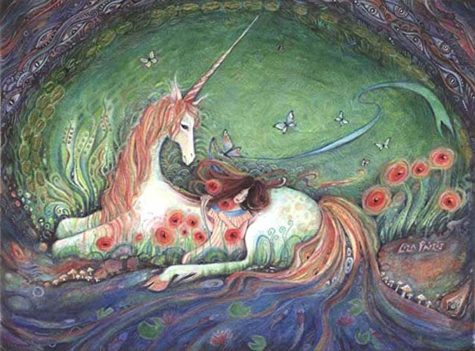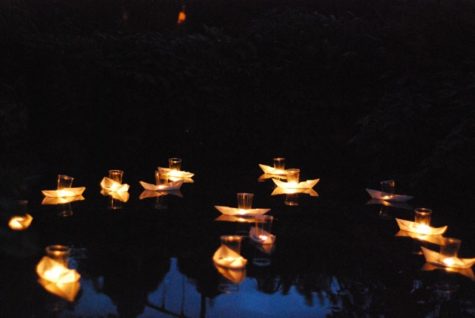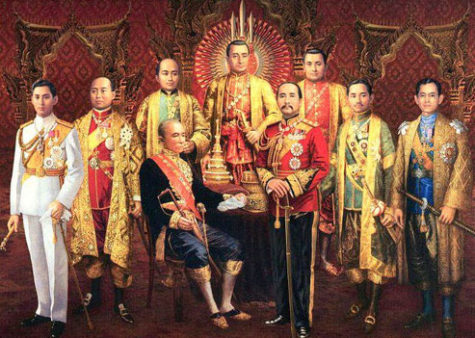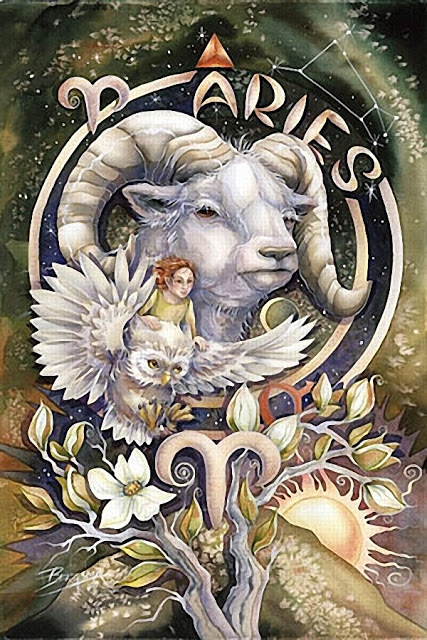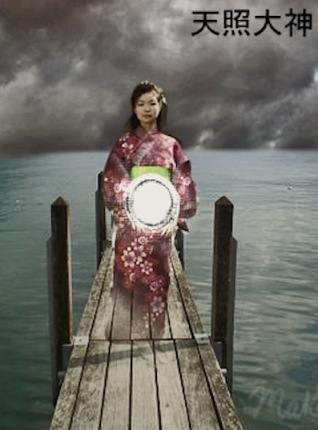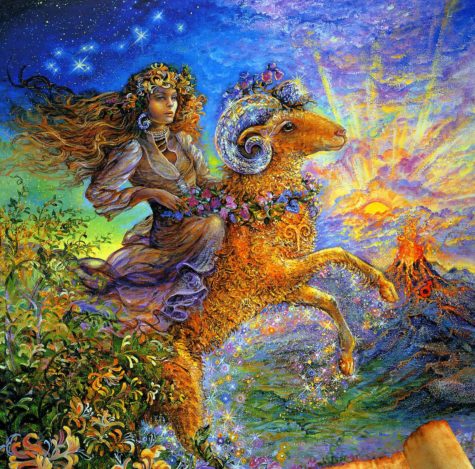Monthly Archives: April 2018
Belenus, whose name means “Bright One,” was one of the most ancient of Celtic gods. The Celtic fire festival, held on the eve of the first of May, known as Beltane, (the fires of Bel) is probably derived from the name of this deity. Beltane fires were lit to encourage the sun’s warmth. These fires also had restorative properties and cattle were herded between them before being loosed on the new spring pastures.
Closely connected to the Druids, ruler of science, healing, hot springs, fire, success, prosperity, purification, crops, vegetation, fertility. It is likely that Belenus (Bel, or Beli) was a fire deity, a patron of flame and the sun’s restorative powers (which explains his classical association with Apollo). Originally he may have been a pastoral deity and in Cymric myth is associated with cattle, sheep and crops. Though this may be because Beltane was the time that herds were moved to the high pastures.
The Celtic god of light and healing, “Bel” means “shining one,” or in Irish Gaelic, the name “bile” translates to “sacred tree.” It is thought that the waters of Danu, the Irish All-Mother goddess, fed the oak and produced their son, The Dagda. As the Welsh Beli, he is the father of Arianrhod by Don.
Patron of sheep and cattle, Bel’s festival is Beltane, one of two main Celtic fire festivals. Beltane celebrates the return of life and fertility to the world — marking the beginning of Summer and the growing season.
Taking place on April 30 (May Eve) and in some areas on May 1, Beltane also is sometimes referred to as “Cetsamhain” which means “opposite Samhain.” The word “Beltaine” literally means “bright” or “brilliant fire,” and refers to the bonfire lit by a presiding Druid in honor of Bile.
Found at: Encyclopedia Mythica
The festival of the Robigalia is celebrated to appease the God Robigus (or perhaps the Goddess Robigo; the gender of this deity, who originated as one of the numinae, is uncertain), who is the deity of wheat-rust, mildew, and blight.
It is an ancient festival of the agricultural calendar, and is celebrated by the Flamen Quirinalis. Both a red dog and sheep are sacrificed to Robigus, along with wine and incense; prayers are then spoken to protect the crops. There is some connection with the ascension of the star Sirius, but it is unclear.
Games (ludi) in the form of “major and minor” races were held. The Robigalia was one of several agricultural festivals in April to celebrate and vitalize the growing season, but the darker sacrificial elements of these occasions are also fraught with anxiety about crop failure and the dependence on divine favor to avert it.
Verminus, a God who protects cattle against worm disease, might also be honored on this day.
The Robigalia has been connected to the Christian feast of Rogation, which was concerned with purifying and blessing the parish and fields and which took the place of the Robigalia on April 25 of the Christian calendar.
Sources:
- Themes: Love; Fertility; Passion; Sexuality; Moon
- Symbols: Star; Moon; Lion; Dove
- Color: Gold
- Incense: Eucalyptus
Sometimes known as the sacred prostitute of Babylon, is the Babylonian goddess of fertility, sexual love, and war, Ishtar encompasses the fullness of womanhood, including being a maternal nurturer, an independent companion, an inspired bed partner, and an insightful adviser in matters of the heart.
Having descended from Venus (the planet that governs romance), she is the moon, the morning star, and the evening star, which inspire lovers everywhere to stop for a moment, look up, and dare to dream. Saturday is Ishtar’s traditional temple day, and her sacred animals include a lion and a dove.
Babylonians gave Ishtar offerings of food and drink on this day. They then joined in ritual acts of lovemaking, which in turn invoked Ishtar’s favor on the region and its people to promote continued health and fruitfulness.
That being said, allow yourself today to reflect on embracing your own sexual being. On a piece of paper, list things about your body and your sexuality that make you uncomfortable. Then, light a pink candle and send pink, healing light to any parts of yourself with which you have emotional discomfort. Embrace your sexual self for who you are and find peace within. After spending time for yourself, consider your own sexual relationships. Focus energy on things within them that are not right and comfortable for you. Send healing to those areas as well. Your sexual relationships should bring joy and pleasure into your life. Remember to be safe in them as well. Thank Ishtar for her presence in your life. Finish your meditations and enjoy the vibrancy of the day.
A magickal alternative, if you have no bed partner, is to use symbolism. Place a knife (or athame, a ritual dagger often representing the masculine divine or the two-edged sword of magick) in a cup filled with water. This represents the union of yin and yang. Leave this in a spot where it will remain undisturbed all day to draw Ishtar’s loving warmth to your home and heart.
If you have any clothes, jewelry, or towels that have a star or moon on them, take them out and use them today. Ishtar abides in that symbolism. As you don the item, likewise accept Ishtar’s mantle of passion for whatever tasks you have to undertake all day.
A Ritual For Ishtar’s Day
- Color: Pottery red, terra cotta
- Element: Earth
- Offerings: Grains. Stars. Give food to those who need it.
- Daily Meal: Wholegrain bread. Cooked grains. Milk and dairy products.
Altar: Set with a cloth of earthy red, and on it place a pitcher of milk and another of wine, bowls of wood and clay filled with grains, olives, figs, and dates, a star, and the figure of a lioness.
Ishtar Invocation
I beseech thee, Lady of Ladies,
Goddess of Goddesses,
Ishtar, queen of all cities,
Leader of all men.
Thou art the light of the world,
Thou art the light of heaven.
At thy name the earth and the heavens shake,
And the gods they tremble;
The spirits of heaven tremble at thy name
And the men hold it in awe.
Where thou glancest the dead come to life,
And the sick rise and walk;
And the mind that is distressed is healed
When it looks upon thy face.
Call and response:
For lo, I am the Keeper of the Storehouse
And I am generous to all men!
From my breasts nourishment spills
From my hands nourishment flows
From my heart nourishment streams
I am the Morning Star
I am the Evening Star
I am the Star of Heaven
And I give unto all humanity.
(After this, all should being the work of inventorying all the resources of the house, in Ishtar’s name, so that they may be used more efficiently and that it can be known what can be given to others out of generosity.)
Sources:
April 16 is the feast day of Saint Bernadette, although in France it is sometimes celebrated on February 18. Saint Bernadette is best known for her visions of the Virgin Mary in 1858 in Lourdes, France and for the healings that have taken place at the location of the visions. St. Bernadette is the patron saint of:
- Physical illness
- Lourdes, France
- Shepherds and shepherdesses
- Poverty
- Those insulted for their faith
- Family
The young shepherdess who saw Our Lady in Lourdes, St. Bernadette, found solace in her suffering by turning her eyes to Our Lord. Suffering today? Pray this prayer from St. Bernadette
“O Jesus, Jesus,” she prayed, “I no longer feel my cross when I think of yours.”
If you’re suffering today, pray this excerpt of one of her prayers:
Let the crucifix be not only in my eyes and on my breast, but in my heart.
O Jesus! Release all my affections and draw them upwards.
Let my crucified heart sink forever into Thine and bury itself in the mysterious wound made by the entry of the lance.”
Saint Bernadette and The Goddess
If you think the visions of Saint Bernadette have no connection to magick and the Goddess think again – here is an alternative version to the traditional story:
On the cold morning of February 11, 1858, there was no wood in the Soubirous home, and no fire to warm them. Bernadette set out with her younger sister Toinette, and a neighbor girl, Jean Abadie, to scrounge in the forest for kindling. Maybe they would get lucky and find a rag or a bone to sell.
Heading out of town, the girls neared the foot of Massabieille, a massive, cliff-top rock formation, within view of the ancient hilltop fortress that served as the traditional landmark of the town. To reach the woods, they had to ford the river Gave at the bottom of the cliff. Bernadette’s mother had warned her not to get her feet wet, for that would surely bring on the asthma, so while the other two girls scampered across the river, Bernadette reluctantly hung back.
According to her own accounts, as she lingered near the banks of the Gave, the girls calling after her as they hurried into the woods, she heard a sound like rushing wind. The sound seemed to be coming from a dark grotto in the rock wall under Massabielle. The noon Angelus bells were ringing from the town. As Bernadette turned to investigate the source of the wind, she saw what looked like a glowing young girl, tiny, white, and smiling brightly. She appeared to be standing above the eglantine, or wild rose, that draped the niche over the entrance to the grotto.
Bernadette rubbed her eyes and looked again. This time, the tiny demoiselle nodded, as if to greet her, and opened her arms, smiling all the while. Bernadette’s initial reaction was fear, but she couldn’t run away. She said she felt like she couldn’t move, but she did manage to instinctively put her hand in her pocket and draw out her rosary for protection. She tried to make the sign of the cross, but found that she couldn’t.
In response, the shining little maiden also produced a rosary, and crossed herself in a gesture of surprising beauty and grace. This time, Bernadette found she could respond, and after crossing herself, she began to feel calmer and a little less overwhelmed. Dropping to her knees, Bernadette began to pray her rosary. The little lady fingered her beads along with her. When they had finished, the tiny thing beckoned her to come closer, but Bernadette was too overawed to move. She then vanished, all smiles and delicate grace, leaving Bernadette to rejoin her companions.
Bernadette’s descriptions of the tiny, white maiden were consistent throughout the course of her visions. The apparition, whom she called aquero, or “that thing” in the local dialect, appeared youthful and girlish. There was nothing particularly matronly or maternal about her. Bernadette repeatedly said that aquero was about the same size as herself, if not a bit smaller. Bernadette was very small for her age. Although she had recently turned fourteen, the combined ravages of illness and malnutrition kept her about the size of an average 10- or 11-year-old. According to Bernadette’s earliest descriptions, aquero looked to be about 12 years old. This is an important distinction, and one that the well-meaning supporters of Lourdes apparently prefer to ignore.
Aquero, according to Bernadette’s initial descriptions, was a jeune fille; a bien mignonette, glowing in a white dress spun of a luxurious, soft, shiny stuff. Her head was covered in a white veil of the same magic fabric, so that only a tiny bit of her hair was revealed in the front. Her eyes were bright blue, and set in a long and very white face. The whole figure shone with a gleaming, white radiance. Around her waist was a blue girdle, which folded in the front and fell almost to the hem of her robe. Her tiny feet, barely visible beneath her robe, were bare, but each was adorned with a single, golden rose. Her rosary gleamed as well, with shining white beads and links of gold.
This costume is quite significant, for in this particular area of the Pyrenees, the locals maintained a tradition of fairy lore that told of the petito damizela in white who still lingered in the forests and grottoes of the region. When Bernadette first called the apparition a petito damizela, which translates as a petite, unmarried young lady, she may have actually been referring to aquero as a Pyrenean fairy woman. These Pyrenean fairies were tiny, enchanting ladies in glowing, white robes. Charming, helpful, and better natured than most fairy folk, they were recognized by their gleaming garments and said to spend much time washing them to snowy whiteness in the fountains outside their grotto homes.
The roses on aquero’s feet were yet another aspect of local fairy lore, as was Bernadette’s reluctance to call her by any name other than “that thing.” According to the tradition, these delightful fairy women sometimes married mortal men, making good wives and housekeepers – for a time. Eventually, the husband would slip up and call his fairy wife by her name, at which point she would disappear back into the fairy world forever.
In the Basque population of the Pyrenees, we have a unique link into the mindset of our most distant ancestors. There is reason to believe the Basques have occupied the Pyrenees region from the remotest antiquity, possibly even to the time of the Cro-Magnon cave painters. The inaccessibility of their mountain fastness kept them relatively isolated from the Indo-European influences that swept the rest of the continent. Consequently, the Basques have retained a unique language and a culture that, while not entirely untainted by foreign contact, still reveals roots reaching down into our most shadowy origins.
Furthermore, the Basques, with their extensive folklore and mythology, are relative latecomers to Roman Catholicism. Religious writers of the 1400 and 1500s continue to speak of the Basques as “gentiles” or “pagans.” The widespread persistence of their ancient beliefs and practices provoked the full wrath of the Spanish Inquisition. The brutal repression of centuries of witch hunts has left its mark, and clearly, some of the tradition that remains is highly adulterated and Christianized, but we can still trace influences extending far back into the Neolithic, and perhaps beyond.
Basque beliefs are rooted in the landscape, in the rugged mountains, the waters, and the caves reaching deep into the earth. They held to that most primitive fundamentalism, the belief in the divinity of the masculine Sun and the feminine Moon. The terms Ost or Eguzki refer to the light of the sun and their god of the firmament. This masculine force, similar to Zeus or Thor, ruled the day and the world of light, but the night belonged to Ilargia, the Moon. Ilargia ruled the hidden, dark side of nature, the underworld of the dead. The Basques were forever fascinated with her mysterious phases and cycles.
However, the Basque people’s deepest and most widespread devotion, long before the arrival of Christianity in the Pyrenees, centered on their female deity, the great goddess who lived in the caves. Her name, perhaps the ultimate irony, was Mari. Devotion to Mari spanned the entire Basque territory, and any respectable hilltop boasted a shrine to Mari, and a statue as well, but the caves remained her favorite habitation.
Within the vast lore and ritual dedicated to her worship, the image of Mari emerges, complex and glorious. She moved like a fireball from mountaintop to mountaintop, trailing wild storms from the subterranean caverns in her wake. She demanded honor and charity from men, punishing those who failed to keep their word or refused to help others. Oddly enough, tradition holds that Mari must only be addressed in the familiar pronoun, putting a unique twist on Bernadette’s surprise at being addressed formally by her aquero. Mari commanded legions of fairy spirits, with varying titles in different locales: the Mairi, or Maide of the mountaintop cromlechs and stone circles, and the fey laminak, often spotted combing their hair in the caverns.
This great and very ancient goddess spawned a vast body of tales and traditions, and the rituals of her devotees in the caves of the Pyrenees kept the Spanish Inquisition busy for years. One of her most vicious persecutors was Juan de Zumarraga, who, in 1528, assisted in the biggest Basque witchhunt. Zumarraga eventually moved on to Mexico, where, as bishop, he persecuted and destroyed the native Aztec culture and religion just as vigorously as he had brutalized his Basque brethren.
One of Mari’s more popular minions is a creature known as Beigorri, a red-haired bull or calf. One of several cattle deities associated with her worship, Beigorri’s chief function is to serve as the guardian of the houses, or shrines, of Mari. Seen in that light, the tales of a magical bovine unearthing a long-lost statue of a female divinity, which then refuses to be worshiped in a Christian sanctuary but instead draws her devotees back to congregate at her wilderness origins, starts to make a certain kind of sense. Perhaps, in these unique Marian traditions, which continue to spring up so freely, even after centuries of repression, we can trace both the reemergence of the Basque Mari, and her conflation, in the aftermath of the Inquisition, into the all-encompassing image of the Christian Mary.
Sources:
According to many pagan calendars, April 15 was the annual festival of Bast. This was Egypt’s most popular festival. A precursor of modern Mardi Gras, it was renowned for parties, revelry, and drunkenness. Herodotus, the Greek traveler and historian writing in the fifth century BCE, claimed that more wine was consumed in Egypt during this festival than during the entire rest of the year. Although many details are lost, Bastet’s festival celebrated female sexuality and generative power.
Boats sailed up the Nile toward Bubastis (her cult city). As each barge approached towns and settlements, it would halt and the mainly female celebrants on board would loudly hail local women congregating on the riverbanks. They would shout sexual obscenities to each other, dance wildly, and perform anasuromai, the ritual act of lifting up the skirts to expose the vulva, associated with laughter, healing, and defiance of grief.
For a socially acceptable way to celebrate:
- Colors: Pink, yellow, clay-color
- Element: Fire
- Daily Meal: Fish.
- Offerings: Give aid to an animal shelter. Give food to household cats.
Altar: Upon a cloth the color of clay, set ten lit candles of pink and yellow, and the figures of many cats. In the center should sit a figure of Bast, and a sistrum. The one who has been chosen to do the work of the ritual should pick up the sistrum before the invocation, with an obeisance to Bast, and it should be shaken after every sentence.
Invocation to Bast
O great Mistress of Cats,
Lady of pleasure in ancient times,
Your eyes sparkle with mischief
And you grant your favors capriciously,
Giving them only where the whim takes you.
Yet we who inhabit this strange world,
Below you yet in power over all your subjects,
We would ask your blessing on us
As we give our blessing to those who are in our mercy.
May we never forget, Lady of tame predators,
Who are not so tame as we might like to believe,
That when we are in a position of power
We should never forget the spirit of those beneath us.
Bless us with joy in life, Lady Bast,
And may we go to our graves
Never forgetting what it is like to play.
Hail Bast! (Repeat response)
Hail Bast! (Repeat response)
Hail Bast! (Repeat response)
For the rest of the afternoon, work should be done at an animal shelter, or spent playing with cats, which on this day alone is not shirking the work. Some folk of the House may choose to be cats themselves for this day; they need do no work, and it is lucky to pet them, but they must not stand on two legs or the spell will be broken. During this time, they must meditate on what it is to be in the strange predicament of the tamed predator who is dependent on the whims of humans
From:
- Encyclopedia of Spirits
- Pagan Book of Hours
The Songkran Festival is a national holiday in Thailand. It marks the beginning of the Thai New Year. It is a traditional Buddhist festival, and it is usually celebrated between 13 and 16 April unless the dates are modified by an official government announcement. In 2019, the holiday will be observed 12–16 April as 13 April falls on a Saturday.
On the first day they will dress up in new clothes and visit the local temple to make merit and then to their grandparents’ house in order to receive blessings. Afterwards, the youngsters will be out on the street taking part in the world’s biggest water fight.
The word “Songkran” comes from the Sanskrit word saṃkrānti, literally “astrological passage”, meaning transformation or change. The term was borrowed from Makar Sankranti, the name of a Hindu harvest festival celebrated in India in January to mark the arrival of spring. It coincides with the rising of Aries on the astrological chart and with the New Year of many calendars of South and Southeast Asia, in keeping with the Buddhist/Hindu solar calendar.
In Thailand, New Year is now officially celebrated on 1 January, Songkran was the official New Year until 1888, when it was switched to a fixed date of 1 April. Then in 1940, this date was shifted to 1 January. The traditional Thai New Year Songkran was transformed into a national holiday.
The Songkran Festival is also known as the water festival. It celebrates water as a ritual of washing away negativity from the year before. People celebrating Songkran take part in a traditional pouring of water that symbolizes washing away back luck and sins from a person’s life. Some people add herbs to the ritual water, as well.
As April is the hottest month of the year, the celebration of water is relevant on many levels of the festival. However, Songkran is not always celebrated in the same traditional manner. In big cities, the country takes to the streets. Cities like Bangkok see a host of street parties and water fights.
The most famous street party in Bangkok is called Silom. This party takes place all along a street that is over 4 kilometres in length. It is a huge party in which thousands of people have water fights with water guns, balloons and any other vessels they can get their hands on. The street is also crowded with vendors selling water guns, toys, food and drinks.
As a national holiday, offices and banks are closed during the three-day period. Many people take this as an opportunity to go visit their families. In addition to traditional water rituals and street parties, there are other key activities that the Thai people participate in during this week. Many will take this time to attend their temple. Some may also participate in an annual spring cleaning of their homes.
It’s Not Just A Giant Water Fight
The Songkran celebration is rich with symbolic traditions. Mornings begin with merit-making. Visiting local temples and offering food to the Buddhist monks is commonly practiced. On this specific occasion, performing water pouring on Buddha statues and the young and elderly is a traditional ritual on this holiday. It represents purification and the washing away of one’s sins and bad luck. As a festival of unity, people who have moved away usually return home to their loved ones and elders. Paying reverence to ancestors is an important part of Songkran tradition.
On the first day of the Songkran Festival, people will offer alms to monks. Thai people do this to make merit which is a good way to start the new year. Another way of making merit during the Songkran Festival is by releasing fish and birds back into the wild.
On the second day of Songkran, many families rise early and take part in traditional Buddhist rituals. They give alms to Buddhist monks. They also take part in a ritual that is known as ‘Bathing the Buddha image.’ During this ritual, devout followers will pour water over the statues of Buddha in their home and at their local temple.
Many cities around Thailand will have Songkran Parades to mark the start of the festival. During Songkran there are also beauty contests to find the most beautiful Thai woman and also the most handsome Thai man. The winners will take part in the parade.
During Songkran, it is traditional for Thai people to return to their ancestral homes and to pour water on the hands of their elders. They will also do this to anyone older than themselves that have been important in their lives like a teacher or other relative.
People also pour rose scented water on Buddha images as part of the ceremony. At the temples they organize ceremonies where you can go and pour rose scented water onto Buddha images and onto the hands of monks.
Another traditional activity for Songkran is making sand pagodas. This is a competition joined by local families to make the most beautiful pagoda made of sand. The original idea was for people to bring sand back to the temple which they may have inadvertently carried away on the sole of their shoes.
The Festivities Around Thailand:
- Central Region
People in this region clean their houses when Songkran approaches. All dress up in colorful clothing or Thai dress. After offering food to the monks, people will offer a requiem to their ancestors. People make merit offerings such as giving sand to the temple for construction or repair. Other forms of merit include releasing birds and fish. Nowadays, people also release other kinds of animals such as buffaloes and cows. Phra Pradaeng hosts traditional Mon ceremonies.
- Southern Region
Southerners have three Songkran rules: Work as little as possible and avoid spending money; do not hurt other persons or animals; do not tell lies.
- Northern Region
On April 7, Baan Had Siew in Si Satchanalai District hosts the’Elephant Procession Ordination’ event with a colorful parade where men dressed in the traditional clothes are taken to the temples on elephants. In northern Thailand April 13 is celebrated with gunfire or firecrackers to repel bad luck. On the next day, people prepare food and useful things to offer to the monks at the temple. People have to go to temple to make merit and bathe Buddha’s statue and after that they pour water on the hands of elders and ask for their blessings.
- Eastern Region
The eastern region has activities similar to the other part of Thailand, but people in the east always make merit at the temple throughout all the days of the Songkran Festival and create the sand pagoda. Some people, after making merit at the temple, prepare food to be given to the elderly members of their family.
- In Bangkok
In Bangkok, the capital city of Thailand, the Khao San Road and Silom Road are the hubs for modern celebration of Songkran. The roads are closed for traffic, and posts equipped with water guns and buckets full of water. The party runs day and night.
Some tips to make the most of the Songkran Festival:
Modern Songkran is renowned for the massive water-fights that take place on the streets of the cities and towns around the country, often continuing for three days or more. While the origins of the festival are far more sedate (more on that later), today Songkran is a pretty boisterous affair.
This is a great time to visit Thailand, but it definitely pays to be prepared if you haven’t experienced it before. Here are some tips to get you through:
- You Will Get Wet
If there is one thing we can say with certainty about Songkran, it’s that you are going to get wet. Very wet. That is, of course, unless you want to lock yourself in your home or hotel room for three or four days. Bringing a sense of fun to the occasion and accepting the fact that you’re going to get soaked many, many times over makes Songkran an infinitely more enjoyable experience. If it all gets too much, find a quiet place to chill out and dry off before returning to the fray.
- You Are Fair Game
If you go out during Songkran, then you are fair game. Don’t complain if you are squirted in the face with a water pistol or someone rubs white powder on your face. Although it might not seem like it, they are actually taking part in a centuries old tradition of paying respect to their elders. Let them do it and smile. Resistance is useless.
- Dress Appropriately
Don’t wear your best clothes. If you are a woman, try not to dress provocatively – particularly spaghetti strap tops or white t-shirts that become revealing when wet. Thai people are traditionally conservative, but some young men will take advantage of Songkran to grope you. Many of them have been partying all night and are drunk.
- Keep Your Cool
Keep your cool at all times. Everyone is just having fun. Be prepared for the buckets of water which have been pre-chilled with ice. Also beware that people might come up to you from behind to smear white powder on your face. If they are polite they will ask first. But, you won’t see that happen often. Try not to move too much when they are doing it as you might end up with the paste in your eyes. However, that is inevitable the longer you stay out.
- Protect Your Electronics
While Songkran is packed with excellent photo opportunities, it is advisable to leave high-end cameras and other expensive electronic equipment at home. Street vendors sell handy waterproof pouches that will effectively protect your smartphone and your cash.
If you take your camera then make sure you also have a plastic bag. Better still, buy a camera that is waterproof. Last year, many people ended up with soggy mobile phones that stopped working. The mobile phone vendors do good business during Songkran repairing them.
- Protect Your Papers
By law you have to carry your passport at all times. However, during Songkran you are running the risk of your important documents getting wet. Make photocopies of your passport to take out with you and leave all important documents in the hotel safe. It is advisable not to carry anything that can be damaged by water with you.
- Equip Yourself
Street vendors sell an impressive arsenal of water guns, buckets and anything else that can be used to soak passers by. Your weapon of choice is up to you. It’s best wear light, comfortable clothes that protect you from the sun. And if you really want to make like a local, be sure to invest in one of the very loud floral shirts you will see on sale everywhere.
- If You Opt Out
If you don’t want to take part in the water fights then you will need to stock up for at least 3-4 days. Some expats go out to buy enough DVD movies and food to last them the holidays. If you do venture out, the chances are high that you will get soaked.
The shopping malls and movie theatres are all open during Songkran. So, you can use these places as a safe haven. However, getting to them safely might be a problem. If you have to use public transport, make sure you use an air-conditioned bus or meter taxi. If you use a normal bus with the windows down or a tuk tuk then you will get soaked. Skytrain and subway are safe havens. Skywalks are reasonably safe.
- Travel Concerns
If you are going out in your car, try to stick to the main roads. There is no point in washing your car before or during Songkran. Wherever you go, your car will get plastered with white paste. Make sure that you have topped up your windscreen wipers with plenty of water. You will use them often. Whatever, you do, don’t forget to LOCK all car doors. If you stop at traffic lights or in a traffic jam, they will try to open your doors.
Lot’s of people drink day and night during Songkran and this new year period in Thailand sees the most horrific crashes on the roads. Most deaths occur on the side roads and in the evening. On the main roads most accidents are caused by drunk driving and speeding. If you are driving take extra care. There are a lot of drunk drivers out on the roads during Songkran. Personally, I don’t like to drive too far during this period and if I do, I stick to the roads that I know near my home.
- Plan Ahead
If you are planning to travel shortly before, after or during Songkran be sure to book ahead. Traditionally, this is a time when many Thais travel to their hometowns to visit family, so flights and even trains and buses can get booked up well in advance. Accommodation in certain areas, such as Chiang Mai, may also fill up quickly around Songkran.
Don’t make the mistake of thinking that the waterfights are only on 13-15 April. This year this is up against the weekend and so some kids might also play on Saturday. In addition, some areas of Thailand have their Songkran celebrations a week later. For example, Pattaya, Bangsaen and Koh Chang. The last of the waterfights will take place in Phra Pradaeng District of Samut Prakan on 24 April 2016.
- Visit a Temple
While Songkran today resembles a massive water-fight, it wasn’t always like that. The more traditional ritual of splashing fragrant water on Buddha statues and on the palms of elders is still common today as a symbol of cleansing. Acknowledging the true spirit of Songkran by visiting a temple is a great way to escape the madness. If you are in Bangkok, check out some of the temples in the Rattanokosin area.
Songkran is not just about water fights. Do make an effort to see the more traditional side. Early in the morning Thai people will be going to the temples to make merit. They will also bathe the monks and Buddha images with rose scented water. In the afternoon, they will build sand pagodas in the temple grounds.
- A Final Thought
If you are in Thailand, then I hope you go out and have some fun! The temperature is above 35 degrees Celsius and this is a good way to cool down. However, if you are not in Thailand, then try visiting your local Thai temple. Many of them will be holding Songkran activities.
The Story of Songkran
Like many celebrations and festivals in Thailand, Songkran has its origins deeply rooted in myth and legend. With Songkran, the myth revolves around Nang Songkran, or the Seven Ladies of Songkran.
In Thailand, the Hindu god Brahma, the creator and four-faced god, was also known as Kabila Phrom. He enjoyed betting and one day met a seven year old boy prince named, Thammabal Kumara who was prodigious in learning, being able to recite scriptures in public. The boy was also reputed to be able to understand the language of the birds.
Kabila Phrom wanted to test the child’s knowledge so he descended to earth and presented three riddles to the boy. Should Thammabal answer the 3 riddles correctly, Kabila Phrom would offer him his head to the boy. However, if the boy failed to come up with answers within seven days, he would lose his own head to Kabila Phrom. The three riddles were as follows:
- 1. Where did a person’s aura exist in the morning?
- 2. Where was a person’s aura at noon?
- 3. Where did it appear at night?
For six days the boy agonized over the answers to the riddles, yet could not come up with them. One the the seventh day, whilst lying under palm trees, he heard a male and female eagle joyfully talking about how they would soon be able to feast on a boy’s dead body. Not knowing the boy was was able to hear, the two eagles revealed the answers to the riddles. Thammabal immediately went to Kabila Phrom and recited the answers,
“In the morning, a person’s aura appeared on his face, so he washed it. At noon, it was at his chest; so, he wore perfume there. And at night, his aura moved to his feet; that was why he bathed them”.
Kabila Phrom had lost the bet and so had to cut off his own head. Kabila Phrom’s head, however, held special powers. It was extremely hot, so if it should touch the ground, the earth would be engulfed in a firestorm, destroying all life; if it should be left in the air, there would be no rain, bringing about vast drought and if it should be dropped into the sea, the sea would dry up.
In order to save the world from these possible disasters, the god’s seven daughters, the Nang Songkran, placed their father’s head on a phan (tray) and carried it in procession around Mount Meru before placing it in a cave on Mount Kailash with many offerings. Thus, at the beginning of each year, Kabila Phrom’s daughters would take turns to bring out the god’s head and carry it in procession around Mount Meru, this celebration is known as Songkran.
The seven daughters represent the seven days of the week and all have their particular names and vehicles that they ride on. The one who carries Kabila Phrom’s head on Songkran Day is called Nang Songkran, Miss Songkran. Thus, in some locations, “Miss Songkran” is crowned, where contestants are clothed in traditional Thai dress.
Sources:
April 9th is National Unicorn Day. Although the holiday is observed all around the world, it has special significance in Scotland, where the unicorn is the national animal.
What mythological creature has been more beloved over the centuries than the unicorn? Symbols of purity and enchantment, unicorns are loved by both children and adults alike and are integral parts of many fairy tales and legends. For all the roles they’ve played in literature, cinematography, and art as a whole, unicorns more than deserve their own day!
Unicorn Day was created to celebrate these majestic creatures and help adults remember how much more fun life can be when we let a little magic in sometimes.
The unicorn was the symbol of purity, innocence, masculinity, and power in Celtic mythology. The day itself has its roots in Scotland, where the unicorn is the national animal. It is unknown how unicorns became associated with Scotland, but one theory says that it happened after narwhals were spotted there, far away from their usual home in the Arctic.
During the reign of William I, in the twelfth century, unicorns began being used on the Scottish royal coat of arms. On it, two unicorns are depicted having chains around their necks. As unicorns were seen as being such powerful animals, the chains may symbolize that the Scottish kings were so strong that they even were able to tame unicorns. In the fifteenth century, during the reign of King James III, two coins—known as the unicorn and half-unicorn—had unicorns on them.
Early depictions of unicorns appeared in Mesopotamian artwork, as well as in ancient myths in China and India. The Greek historian Ctesias referenced an animal with one horn in 400 BCE. He likely was referring to the Indian Rhinoceros, but he described the creature as having a white body and purple head, with a multicolored horn on its forehead. He wrote that the animal was very fast and that those who drank from its horn were protected from some illnesses.
There have been other legends about the power of unicorn horns. One says poisoned waters, such as rivers, can be purified with a unicorn horn so that other animals can drink it. Because of this, “unicorn horns” became very pricey, costing more than gold. These horns were actually made from the protruding tooth of narwhals. “Powdered unicorn horns” were sold in some London pharmacies until the mid-eighteenth centuries.
Unicorns were mentioned as far back as antiquity—ancient Greek writers believed they lived in the faraway and exotic country of India, which was then largely unknown to Europeans. However, the unicorn was then thought to be a powerful, fierce animal that was not to be meddled with.
In the Middle Ages, the unicorn’s image was based greatly on Bible passages that were thought to speak of these animals, and unicorns slowly came to be seen as a symbol of strength, the purest kind of love, and the pets of virgin women. In fact, there is even a sculpture of the Virgin Mary holding a unicorn on her lap and patting it in Warsaw’s National Museum.
The Christian Greek text Physiologus says that the only way a unicorn can be caught is with a virgin maiden. In that text, a unicorn jumps in the maiden’s lap, and she suckles it and takes it to the king’s palace. Because of this, the unicorn was compared to Christ. According to one other legend, Genghis Khan decided not to take over India because he came upon a unicorn that bowed down to him.
How To Celebrate!
One way to celebrate would be to practice a little bit of Unicorn Magick, there are a variety of Unicorn spells in our Book of Shadows. Or you could visit the Magickal Apothecary and create a Unicorn Protection Charm or Healing Sachet.
Another way to celebrate this day might be to find a fun, fanciful activity. How about inviting some friends over to bake colorful cupcakes or cookies? A quick google search will give you lots of ideas and recipes.
You can top them with colorful icing and sprinkles. Or bring in a plate of them to work and become everyone’s favorite person in no time!
More Ideas:
- Make some unicorn crafts.
- Read or watch The Last Unicorn.
- Read another book that is about or features unicorns.
- Pick up some unicorn-themed clothes.
- Buy a unicorn questing license. Lake Superior State University in Sault Ste. Marie, Michigan, has issued permits for “unicorn questing” since 1971.
- See The Hunt of the Unicorn at The Cloisters in New York City.
- Bravely go all out with the unicorn hair dye.
- Be a little more subtle with a rainbow of nail polish or a touch of glitter?
- Too Faced is even selling a whole range of unicorn inspired make-up.
Sources:
Fête of the Little Boats or Fête des Petits Bateaux is celebrated by the towns along the Moselle river in France on April 6th. A fête is a celebration or a festival.
To celebrate the coming of Spring, children make little pine wooden boats to set sail on the river. On this special day, they place lit candles on the boats and make a wish for their futures.
If someone finds their boat, it will bring them good luck for the rest of the year. It’s even better if the candle is still lit!
Sources:
Officially called ‘King Buddha Yodfa Chulaloke the Great Day and Chakri Dynasty Memorial Day’, Chakri Day commemorates the establishment of the Chakri Dynasty in 1782. It falls on April 6 each year, with the public holiday on the following Monday if it falls on Saturday or Sunday.
This day commemorates the establishment of the Chakri Dynasty (the current ruling house) and the founding of Bangkok by King Rama I in 1782.
In general, Chakri Day day celebrations are low key, particularly compared to the Songkran Festival to follow. While not an outright Buddhist holiday, ceremonies are held at the Temple of the Emerald Buddha (Wat Phra Kaew) in Bangkok and other temples around the country.
The national flag is displayed. People participate in traditional ceremonies and leave flowers and garlands at the statues of Kings in the House of Chakri.
The King and the royal family presides over religious ceremonies held at the royal chapel. He also pays respect to his predecessors at the Royal Pantheon and lays a wreath at the statue of King Rama I at the Memorial Bridge. All government officials take part in the wreath-laying ceremony.
Sources:
Aries is the first sign of the zodiac. The sun enters Aries at slightly different times each year, usually around March 21, sometimes the day before or the day after.
- Symbol: The Ram
- Element: Fire
- Gemstone: Diamond
- Keyword: I Am
Arians like responsibility and enjoy managing and organizing others. They are magnetic and outgoing, inspiring others to action with their drive and enthusiasm. Arians can be tactless and impatient at times. They enjoy taking risks, and often find this stimulation in adventurous, outdoor activities.
From 365 Goddess, we have this for today:
- Theme: Arts; Excellence
- Symbols: Stone, Mirror
- Presiding Goddess: Ishikore-Dome
About Ishikore-Dome:
This Shinto goddess is the protectress of all stone cutters and smiths, having fashioned the mold from which an eight-petaled mirror was made for Amaterasu (the sun goddess). The beauty of Ishikore-Dome’s creation was such that Amaterasu came out of hiding, bringing spring’s wonderful sunshine with her! Similarly, Ishikore-Dome tempts us to come out of our home-cave today, explore and express our talents, and enjoy the warmer weather.
To Do Today:
The sign of Aries is said to produce a feisty, courageous spirit, which is exactly what it takes sometimes to stop being the proverbial wallflower and try new things. If there’s an art form you’ve always wanted to try, or one that you love but hesitate to try because of perceived shortcomings, let Ishikore-Dome’s encourageing energy nudge you into action today. Remember, Buddhists believe that developing artistic proficiency comes down to three things: practice, practice, practice!
To conduct yourself with greater courage and a unique artistic flair, make a simple Ishikore-Dome charm from a small mirror. Face-down on the mirror, glue a symbol of the area in your life in which you need more creativity, mastery, or mettle and carry it with you. This symbolically reflects your desire to the goddess.
More About Sun in Aries:
The Sun is in Aries from March 21 to April 19, depending on the year.
- Ruler: Mars
- Season: Spring
- Modality: Cardinal
- Metal: Iron
- Stone: Amethyst, Diamond
- Color: Red
- Flower: Honeysuckle
- Anatomy: Head, face.
- Attributes: active, initiating, leading, independent, aggressive, impatient, combative, energetic, pioneering, naive, assertive
Aries is the first sign of the zodiac, and Aries natives are the first to start—and the first to finish—whatever they set out to do. Aries is an active, energetic sign. People with Sun in Aries are direct, straightforward, and uncomplicated. They expect the same from others, and are baffled when they don’t always get it.
The body comes first with Aries. Sun in Aries people are natural athletes. At the very least, their natural inclination is to use their bodies to get things done. They’re not given to long, drawn-out emotional moments; nor are they big on planning ahead. Instead, they live their lives simply. What is happening right now is most important to Aries. Impatience is a definite vice, and innovation is a huge strength.
Aries loves to start anything new, and they have trouble sitting still. They are pioneers in whatever they do, and there is a very basic quality of bravery in these people that is unmistakable! Aries generally knows what they want, and they know the quickest route to getting it. They take shortcuts if they must, but generally everything is aboveboard. Underhanded just isn’t their style.
Some Aries people are bold, but even the quieter ones are brave and even plucky in their own way. Independence is their birthright. Nothing gets them going more than a fresh slate, the promise of a new day, and a brand new start.
Aries enjoys a challenge, and Aries Suns are happiest when their lives are moving forward and active. There’s a childlike quality to all Aries Sun people, and it’s often quite charming.
Source: Cafe Astrology
